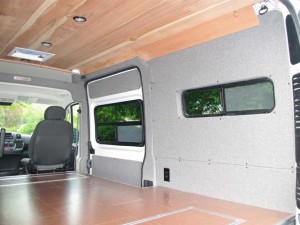 So now you have finished building your own motorhome. Good for you! But are you really finished with it? Well, if you forgot about van insulation, then your project is far from completed!
So now you have finished building your own motorhome. Good for you! But are you really finished with it? Well, if you forgot about van insulation, then your project is far from completed!
If you’re going to drive around in a motorhome for the foreseeable future, no matter how long or short your trips might be, you have to consider the forces of nature. You’ll be hundreds of miles away from any residential-grade heating or cooling. All you have to protect you from the heat or cold are the walls of your motorhome and your clothes. But what if those fail?
Enter van insulation. So read on to know more about how to weatherproof your vehicle effectively!
Science Bits
So why does your camper need insulation and what does it exactly do? The simplest answer is this: a well-insulated van is a lot easier to heat and cool. And when it comes to insulation, it deals with three types of heat transfer: radiation, conduction, and convection.
Radiation refers to the transfer of heat transferred through air or space (like the heat of the sun).In your campervan, heat from radiation comes from the windows. Sunlight passes through the glass and heats up the interior. While this can be nice when it’s cold outside, it can be a pain in the neck during the hot summer months.
Conduction refers to heat being transferred through solid surfaces. A perfect example would be a frying pan on a stovetop that is hot to the touch. When the heat from the sun (transferred by radiation) touches the metal body of your vehicle, it can also heat the interior via conduction. The same thing happens when it’s cold.
Lastly, convection refers to how heat moves through gas or liquid. A good situation will be the air in your van, where it feels warmer up and cooler down.
Related: Tips & Tricks: Making RV Living Bearable During Winter
 What to Look for in Van Insulation Material
What to Look for in Van Insulation Material
When you go out to buy the insulating materials for your campervan, these are the things you should look for aside from its R-Rating.
1. Toxicity – Believe it or not, some insulating materials on the market have the tendency to be toxic on their own, or release toxic compounds. As much as possible, you don’t want any particles or gases contaminating the space before, during, and after installing the insulation.
2. Moisture resistance – Resistance to moisture is connected to toxicity in the sense that it can prevent the growth of molds. And with molds comes potentially harmful particles. You have a relatively small space in a campervan, which means you’ll generate a lot of moisture from cooking, showers, and even breathing. Moisture-resistant insulation will stop any mold growth in a very cost-effective way.
3. Cost – Living in a campervan has its perks, but it can still get a bit expensive to maintain this kind of lifestyle over time. So try to get the most affordable products when you can to offset the living costs of being a modern nomad.
Should You Go DIY?
There’s a good amount of money to be saved if you do go the DIY route! Should you want to make insulation panels on your own, you have an option to get cheaper materials. Not to mention, you don’t have to pay for labor. But the thing is, DIY insulation is likely to fail and not last as long as professionally done ones. So unless you’re absolutely sure that your solution can withstand rigorous usage, going this route is only for serious DIYers who have a good-enough understanding of what they need to do.
Related: 5 Effective RV Window Insulation Techniques
Extra Considerations
Not a lot of people might think of this, but you should! Take a look at your camper van windows. Are they durable-enough and properly sealed? Because you might not be aware, but they are critical to the effectiveness of your insulation methods. You can weatherproof the vehicle’s walls all you want, but what if the cold or the heat still seeps in or out through cracks in the windows?
You do not want that, as do we. We at Peninsula Glass can help you with your van windows needs to fully protect you from what Mother Nature can throw your way. Talk to us today!
